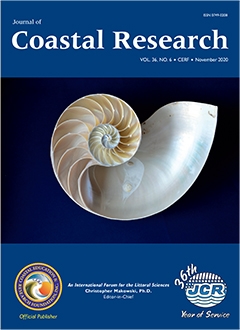Lindner, B.L.; Holden, W.; Neuhauser, A., and Evsich, R., 2020. Climatology of tropical cyclone strikes along the southeastern coastline of the United States. Journal of Coastal Research, 36(6), 1162–1177. Coconut Creek (Florida), ISSN 0749-0208.
It has been theorized that tropical cyclones originating in or passing through the Gulf of Mexico (hereafter referred to as GOM tropical cyclones) may significantly impact communities along the Atlantic coast of the southeastern United States. To explore this hypothesis, site-specific climatologies were compiled using National Hurricane Center records of tropical cyclones that passed within 139 km of either Savannah, Georgia, or Wilmington, North Carolina, during the years 1851–2018. Return periods for tropical cyclones are longer for Savannah than for Wilmington, particularly for intense hurricanes. Intense GOM hurricanes are weakened by land interaction, which would result in longer return periods. A secondary maximum in the number of tropical storms early in hurricane season is more pronounced with proximity to the Gulf of Mexico, which is again consistent with the contribution from GOM tropical cyclones. Moreover, the percentage of tropical cyclones that passed near Savannah but did not make landfall is higher than that for Wilmington, again an indication of the significance of GOM tropical cyclones. Further evidence of the influence of GOM tropical cyclones is seen in the difference in approach angle and translational velocity between tropical storms and hurricanes. In addition, translational velocities for tropical cyclones increase with latitude, and translational velocities for tropical cyclones near either Savannah or Wilmington increase as the hurricane season progresses. Both relationships are likely due to the interaction of tropical cyclones with synoptic and planetary-scale winds. The median date for tropical cyclones has shifted earlier in recent decades for both Savannah and Wilmington, which is potentially an indication of climate change. An improved understanding of the climatology of tropical cyclones could lead to enhanced city planning, building codes, infrastructure, and resource management.





